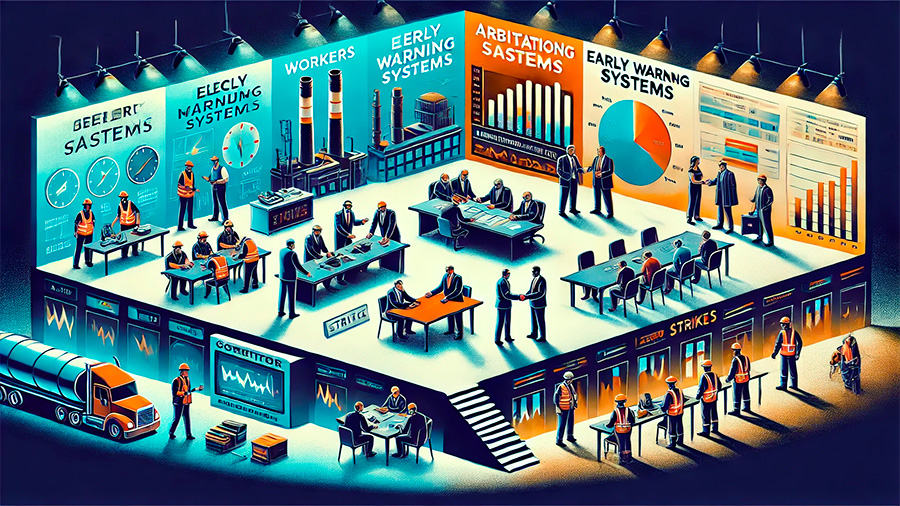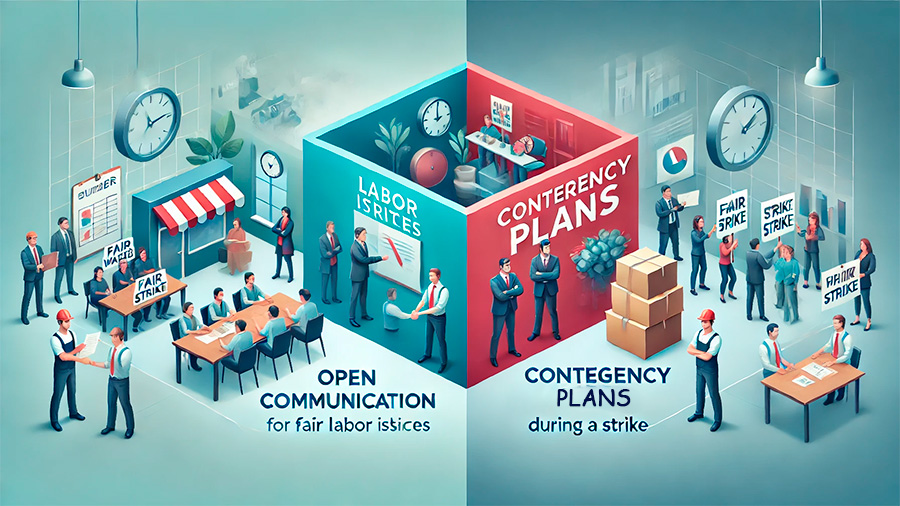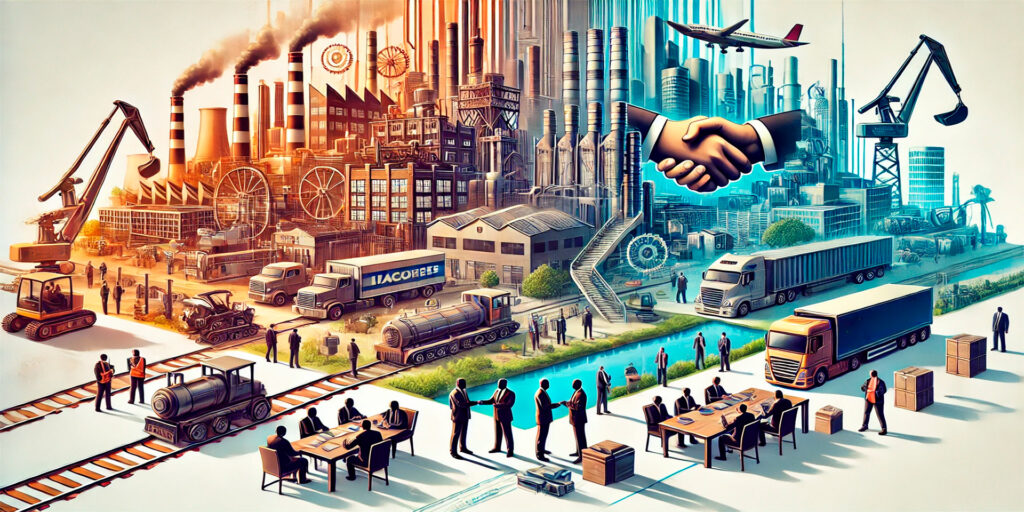Worker strikes can have significant economic consequences, disrupting industries, halting production, and straining supply chains. From manufacturing to transportation and public services, strikes can lead to widespread financial losses for businesses, reduced output, and even higher consumer prices. To prevent these crises from escalating and ensure economic stability, both governments and businesses need to adopt effective measures to mitigate the impact of strikes.
This article explores practical strategies that governments and businesses can implement to resolve strikes, maintain operational continuity, and reduce the long-term economic impact of labor disputes.
Understanding the Economic Impact of Worker Strikes
Worker strikes, whether in public or private sectors, can have a ripple effect on the economy. Industries like transportation, manufacturing, healthcare, and education are particularly vulnerable to strikes, as they provide essential services that drive economic activity. When strikes occur in these industries, the consequences can be severe, leading to production delays, revenue losses, and disrupted services. The longer a strike lasts, the greater the financial damage, both to individual businesses and the broader economy.
1. Halting Production and Supply Chains
One of the most immediate impacts of worker strikes is the disruption to production lines and supply chains. In industries such as manufacturing, strikes can cause production to grind to a halt, delaying the delivery of goods to markets. Similarly, transportation strikes can lead to supply chain bottlenecks, preventing essential products from reaching consumers and businesses.
How strikes affect production and supply chains:
- Delayed production schedules: Strikes in factories can lead to backlogs in orders and lost revenue as companies struggle to meet demand.
- Supply chain disruptions: Transportation strikes delay the movement of goods, creating shortages in retail and manufacturing sectors.
2. Rising Costs and Consumer Prices
As strikes disrupt production and supply chains, the costs associated with these delays are often passed on to consumers. Businesses facing higher operational costs due to prolonged strikes may raise prices to offset the financial impact. Additionally, shortages of essential goods caused by supply chain interruptions can lead to price inflation, exacerbating the economic effects of the strike.
Economic impact of strikes on consumers:
- Increased product prices: Shortages and delays in production drive up the prices of goods and services for consumers.
- Higher operational costs for businesses: Companies may face increased expenses for alternative transportation or temporary labor during a strike.

Government Measures to Mitigate the Impact of Strikes
Governments play a key role in preventing and resolving strikes, especially in critical industries that affect national economies. By enacting policies that promote fair labor practices, fostering negotiation between workers and employers, and creating frameworks for conflict resolution, governments can help reduce the likelihood of strikes and ensure faster resolution when they occur.
1. Mediation and Arbitration Services
One of the most effective ways for governments to prevent strikes from escalating is through mediation and arbitration services. By acting as neutral third parties, government mediators can help facilitate negotiations between workers and employers, ensuring that both parties reach a fair resolution without resorting to prolonged labor actions. Arbitration can also serve as a final step in resolving disputes, providing legally binding decisions that bring an end to labor disputes.
How mediation and arbitration reduce strikes:
- Neutral conflict resolution: Government mediators provide an impartial perspective, helping both parties find common ground and avoid strikes.
- Legally binding decisions: Arbitration ensures that disputes are resolved quickly, preventing prolonged labor disputes from damaging the economy.
2. Creating Early Warning Systems for Labor Disputes
Governments can also implement early warning systems to identify potential labor disputes before they lead to strikes. By monitoring labor market conditions, tracking collective bargaining negotiations, and maintaining open communication with unions and employers, governments can identify potential conflict areas and intervene before disputes escalate into strikes.
Benefits of early warning systems:
- Proactive intervention: Early warning systems allow governments to address labor disputes before they result in work stoppages.
- Reduced economic disruption: Preventing strikes before they occur helps maintain production levels and protects the economy from unnecessary losses.

Business Strategies for Addressing Worker Strikes
While government policies can help resolve large-scale strikes, businesses must also adopt strategies to reduce the impact of labor disputes within their operations. By fostering positive labor relations, maintaining open communication with employees, and preparing contingency plans for potential strikes, businesses can minimize the economic damage caused by labor disputes.
1. Promoting Fair Labor Practices
One of the most effective ways for businesses to prevent strikes is by promoting fair labor practices and addressing worker grievances early. Ensuring that workers receive fair wages, benefits, and safe working conditions can significantly reduce the likelihood of labor disputes. Additionally, businesses that invest in employee well-being and create a positive work environment are less likely to face labor strikes.
How fair labor practices prevent strikes:
- Improved employee morale: Fair treatment of workers leads to higher job satisfaction and reduces the likelihood of labor disputes.
- Reduced risk of strikes: Addressing worker grievances early helps businesses avoid costly strikes and maintain operational continuity.
2. Developing Contingency Plans for Strikes
Businesses should also prepare for the possibility of strikes by developing contingency plans that allow them to continue operations during labor disputes. This may include cross-training employees, establishing relationships with temporary staffing agencies, or using automation technology to reduce the reliance on labor-intensive processes. By having contingency plans in place, businesses can minimize the disruption caused by strikes and continue meeting customer demand.
Key elements of effective contingency plans:
- Cross-training employees: Ensuring that workers can cover multiple roles allows businesses to maintain operations even during a strike.
- Automation and technology: Investing in automation reduces dependency on labor, ensuring that production continues even if workers strike.
Long-Term Solutions for Preventing Economic Crises from Strikes
While immediate responses to strikes are important, long-term solutions are needed to prevent economic crises caused by labor disputes in the future. Both governments and businesses must work together to create a labor environment that fosters collaboration, ensures worker rights, and minimizes the risks of strikes.
1. Strengthening Worker-Employer Relationships
Building strong relationships between workers and employers is a key long-term solution for preventing labor disputes. Open communication channels, regular dialogue between management and labor unions, and collaborative decision-making processes can create a more positive work environment and reduce the likelihood of strikes. By investing in relationships with their workforce, businesses can create a culture of trust and cooperation that benefits both employees and employers.
How strong relationships prevent labor disputes:
- Increased trust between workers and management: Open communication fosters a collaborative work environment and reduces the potential for conflict.
- Proactive problem-solving: Regular dialogue between workers and employers helps address issues before they escalate into strikes.
2. Implementing Comprehensive Labor Policies
Governments can play a role in preventing future strikes by implementing comprehensive labor policies that protect worker rights and promote fair employment practices. These policies should include wage protections, safe working conditions, and mechanisms for workers to voice grievances without resorting to strikes. Additionally, governments can promote labor market stability by supporting skills development and job training programs, ensuring that workers have access to quality jobs that meet their needs.
Benefits of comprehensive labor policies:
- Protecting worker rights: Clear labor laws that ensure fair treatment of workers help reduce the risk of labor disputes.
- Promoting workforce development: Government support for training and skills development ensures workers are equipped for the demands of the modern economy.
Conclusion
Worker strikes can create significant economic challenges, disrupting industries, supply chains, and consumer markets. To prevent and mitigate the impact of strikes, governments and businesses must adopt a range of strategies, from mediation and arbitration services to fair labor practices and contingency planning. By fostering positive labor relations and promoting collaborative decision-making, both parties can reduce the frequency and severity of labor disputes, protecting the economy from the long-term effects of worker strikes.



